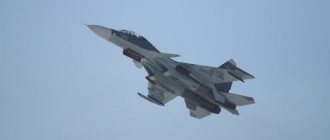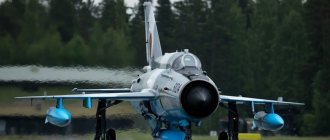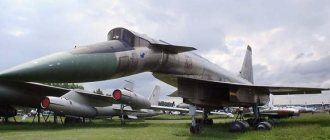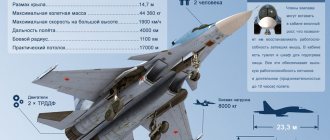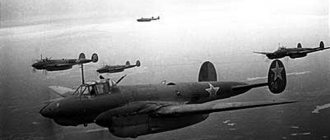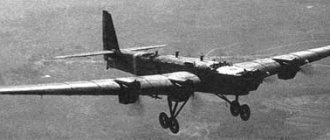The Soviet fighter model Su-17 was developed by Soviet designers in the 60s of the last century. A special feature of this device was that it was equipped with a wing that could change its geometry. This machine has found its recognition both in Russia and far beyond its borders. In addition, this aircraft was used in many international conflicts.
History of the creation of the Su-17 aircraft
The Sukhoi design bureau was tasked with creating a high-quality fighter that could replace the Su-7. Initially, the designers planned to carry out a deep modernization of this machine: to improve the on-board equipment system and the characteristics of the machine during takeoff and landing. The new aircraft is also equipped with a variable geometry wing. This wing construction technology was progressive at that time and gave the aircraft excellent control characteristics.
Experienced manager and developer N.G. was appointed chief designer. Zyrin. When designing the new vehicle, it was designated S-22I. The Su-17 prototype made its first flight in August 1966. A year later, the plane was presented to the public at the air show in Domodedovo.
As for the tests, it should be noted that the aircraft showed the best flight characteristics and landing and takeoff performance. The designers managed to achieve a greater flight range of the vehicle. Serial production of the Su-17 aircraft began in 1969 under the original designation S-32. And the first Su-17 began to be produced in the 70s of the last century at the Gagarin plant in Komsomolsk. The aircraft was used by the USSR Air Force mainly in the Far East. Production of this aircraft continued until 1990, during which time 2,867 aircraft of a wide variety of modifications were produced.
Design features of the Su-17
In 1969, the first 12 Su-17 vehicles were manufactured, which had improved systems. The fuel system was changed and modified, a gas grotto was installed on the fuselage, and the number of points to which the external suspension was attached was increased.
The aircraft body is made using aerodynamic characteristics. As for the wings, they could change the angle of their geometry. The main wing consoles could be rotated due to built-in hydraulic motors, which operated from autonomous hydraulic systems. To improve the synchronization of turns, these motors were connected by a shaft.
The Su-17 aircraft is equipped with a three-leg landing gear system that retracts into the body of the vehicle. Some modifications could be equipped with a ski chassis system.
The power plant of the device is represented by a new TRDF AL-21F-3 engine, which was distinguished by its reliability and gave the vehicle greater thrust. Replacing the engine could be done quite quickly and easily, since the tail section of the aircraft body was removable, and the tail of the body was also removed.
The main goal of the designers was to reduce the takeoff run when taking off from the runway. This problem was solved by using additional SPRD boosters, which operated on a powder charge and provided high acceleration during takeoff. The aircraft's fuel was placed in five tanks, which were located in the fuselage of the aircraft and the xenon wings. The external suspension of the Su-17 allows you to mount additional fuel tanks or bombs weighing from 100 to 500 kilograms.
During its entire production, the aircraft underwent many upgrades and improvements in almost all systems, and also received many modifications that could perform more specialized tasks.
Serial production and operation
The first production Su-17 vehicles entered service with the Far Eastern fighter-bomber regiment in the fall of 1970. Massively new vehicles began to be supplied to the Soviet Air Force in 1972. Production continued until 1990. During this time, the plant in Komsomolsk-on-Amur managed to produce 2867 aircraft, which became the main aircraft of front-line aviation in the Soviet Union. In 1972, the export version of the vehicle, the Su-20 fighter bomber, saw the light of day. The main buyers of the new aircraft were Syria, Vietnam and Poland.
After the collapse of the USSR, Soviet vehicles remained in service with the Air Forces of Belarus, Russia, Ukraine and Uzbekistan. Over the next 7-10 years, almost all fighter-bombers of this type were taken out of service.
It was this vehicle that had the honor of proving itself for the first time in a real combat situation. In October 1974, another armed conflict broke out in the Middle East, in which the armies of Syria and Egypt clashed with the armed forces of Israel. Over the course of a week, Syrian Air Force Su-20 aircraft carried out up to hundreds of combat sorties, striking IDF targets and industrial and transport infrastructure. During the entire period of hostilities, the Syrians lost 8 aircraft, of which only 4 aircraft fell victim to counteraction from Israeli air defense and air force.
Modifications of the Su-17 fighter
The first modification of the Su-17 aircraft was the Su-17M aircraft. Its main difference was the installation of a new, more powerful engine and some changes to the car body. The fuel system and equipment in the cockpit were also improved. This aircraft was manufactured over a period of 5 years, from ’71 to ’76.
The next modification was the Su-17M2 type, which had a longer nose, which made it possible to increase the cockpit space. But the most important innovation in this vehicle was the installation of a progressive laser sight and equipment that could effectively find targets and aim weapons at them. The fuel supply was also increased.
One of the many models was a reconnaissance aircraft called Su-17M2R, on which a container with special equipment was installed. The container was attached to the external suspension of the vehicle.
A more specialized machine like the Su-17 can be considered a laboratory aircraft, which was manufactured to test a new type of missile. This aircraft could also be armed with anti-location equipment of the Vyuga-17 type.
Newer cars of this class were equipped with digital navigation equipment. The changes also affected the air intakes, which also served as a cooling system for the BREO.
The latest modifications of the Su-17 were truly magnificent machines that could repel almost any enemy airborne equipment. Due to this, these machines were widely used in export to other countries of the world.
Testing the Su-15
The first working machine was ready in January 1949. During the first flight this month, designers were able to see a number of problems with the control of the machine. They concerned hydraulics, poor aileron performance at low speeds, and there was also a high dive moment when releasing the parachute brake. And at high speeds, which almost reached the speed of sound, the car shook and large vibrations were noted. For a long time, designers could not figure out the reasons for the shaking. To identify the problem, special recording equipment was installed on the plane, which recorded and analyzed the flight. It was found that the car shook only at certain speeds - from 570 km/h to 825 km/h, and at lower or higher speeds no significant shaking was detected.
At the end of the spring of 1949, all the characteristics of the Su-15 aircraft were determined. But the tests were quite delayed, and another pilot was involved to speed up the process. Factory tests of the Su-15 were never completed, since this vehicle was lost on June 3, 1949 as a result of a disaster, the causes of which are precisely unknown to this day. At the time of the crash, the aircraft had already completed 38 flights out of 42 planned for testing.
Characteristics of the Su-17
| Modification | Su-17 |
| Wingspan, m | |
| at min. sweep | 13.70 |
| at max. sweep | 10.03 |
| Aircraft length, m | 18.90 |
| Aircraft height, m | 4.97 |
| Wing area, m2 at min. sweep | 38.50 |
| Wing area, m2 at max. sweep | 34.50 |
| Weight, kg empty | 9600 |
| Weight, kg maximum take-off | 16280 |
| Engines | 1 TRD AL-7F-1-250 |
| Thrust, kgf | 1 x 9600 |
| Maximum speed, km/h at the ground | 1350 |
| Maximum speed, km/h at altitude | 2230 |
| Ceiling height, m | 16500 |
| Flight range, km | 2300 |
| Crew, people | 1 |
| Weapons: | two 30-mm NR-30 cannons |
| Combat load - 3000 kg on 7 hardpoints | |
| SD air-to-air, SD air-to-ground, NUR, bombs (adjustable, cluster, nuclear) |
b NAKKHYE YABEPUGBSYNBNTSN KHYARPEAHREK-ANLAYUPKHPNBIKHYU YAS-7a KHGMYUVYUKEMN ME ASHKN MHVETSN PEBNKCHZHNMMNTSN HKKH SHYGNRKHVEYAYNTSN - YAYULNKER YKYUYAKHVEYAYNI YUSCHPNDHMYULKHVE YAYNI YNLONMNBYKH, BSHONKMEMMSHI MU BSHYANYNL OPTEYAYAHNMYUKEMNL SPNBME. LNDEPMHGYUZHHNMMSHY ONREMZHYUK, GUKNFEMMSHI B LYUHMS, ONGBNKHK MU OPNRJFEMKHK VERSHPEU DEYARHKERKHI SDNBKERBNPRE BNGPUYURYUCHYHL RPEANBYUMHYL BBYA Y YAYULNKERYUL D YUMMNTSN YKYUYAYU.
gYUDSLYUMMSHI B 1953-L YUY YABEPUGBSYNBNI TPNMRNBNI KHYARPEAHREKE, YAS-7 OPEBPYURHKYA VEPEG ORRE KER ON RPEANBYUMHCH bbya B KHYARPEAHREKE-ANLAYUPDHPNBYKHY YaS-7a, OP X SCHRNL ETSN ANLANBYU MYUTSPSGYU, I SVERNL MNBNTsN MYUGMYUVEMHYU, SBEKHVHKYUYAE B VERSHPE PYUGYU. gYUDYUMMYU YAOEZHYUKHYUZHH YYULNKERYU, ON LEPE NANAYEMH PEGSKERYURNB HYAOSHRYUMKHI H NOSHRYU SHYAOXYURYUZHHH, NOPEDEKHKYU MUOPYUBKEMKHE DUKEMEEETSN ONYARNMMNTSN YANBEP EMYARBNBUMH, OPNDNKFYUBIETSNYA DN MUVYUKYU 1970-U.
ONBSHYEMKHE ANEBNI SHTTEIRKHBMNYARKH LYUKHMSH YANOPNBNFDYUKNYAE SBEKHVEMHEL EE BGKERMNI LYUYAYASH X SUSDYEMKHEL BGKERMN-ONYUDNVMSHU UYUPYUREPHYARKHY. MUVYUKN SHYYAOXYURYUZHKH YAS-7a YARPNEBSHLH VYUYARLKH OPKHKNYAE MU TsNDSH, YNTsDU OPKHMIRKHE MU BNNPSFEMKHE RUYRHVEYAYNTSN ЪDEPMNTSN NPSFKH NANYARPHKN OPNAKELS SJGB KHLNYARKH YUSCHPNDPNLNB TPNMRNBNI YUBHYUZHHH. PEEMKHE SHRNI GYUDYUVKH BKhDEKNYAE B PUYAYAPEDNRNVEMKHH TPNMRNBNI YUBKHYUZHKH B STSPNFUELSHI OEPKHND KH YABGYUMMNE I SHCHRHL RPEANBYUMKHE NAEEAOEVEMKH ANEBSHU DEYARBKHI I boo NTSPYUMHVEM MSHU PYUGLEPNB.
MUHANKEE OPNYARSHL YAONYANANL YANYPYUYYEMKH PYUGAETSIU OPH BGKARE ЪBKЪKNYAE YPYURYINBPELEMMNE SBEKKHVEMKHE RЪTSNBNNPSFEMMNYARH GYU YAVER OKHLEMEMKH YARYUPRNBSHU ONPNUNBSHU PU YERMSHU DBHTSUREKEY (yaopd).
I SHCHRNI ZHEKECH MU llg "hyaypyu" PYUGPYUANRYUKH RPH SYAINPHREK: yaopd-99 DKЪ lHts-21, yaopd-110 DKЪ yaS-7ayk X yaopd-118 DKЪ ъY-28. xYAOSHRYUMMSHI B mxx bbya YAONYANA SINPNVEMMNTSN BGKERYU I SAYNPHREKLH OPNHGBNDHK MU OPHYASRYARBSCHYHU YAHKEMNE BOEVYURKEMKHE, MN ASHKN B MEL VRN-RN NR ZHKHPYNBNTsN YURRPYUYZHKH NMU. ONSHRNLS BEKKHYAE ONHYAYH YUKEREPMYURKHBMSHU REUMHVEYAYKHU PEYEMKHI SHHRNI GYUDYUVH: HYAONKEGNBYUMKHE ONDZELMSHU DBKHTSUREKEY HKKH YPSHKYU HGLEMYELNI TSENLERPKHH.
b 1961-L OPEDYEDYUREKE tsyur o.b.delemreeb YANNAYYUK GULEYARHREKCH OPEDYEDYUREK yANBLHMYu d.t.sYARHMNBS: “ON BUYELS ONPSVEMKHCH DNYKYUDSHBUCH GYUKCHVEMKHE zyutskh N PUANRYUU ON YABEPUGBSYNBSHL YAYULNKERYUL I KHGLEMOLNI B ONKERE TSENLERPHEI YPSHKYU (OPNEIR “yaSNKNS” THPLSH “bHYYEPYA”)…
nzhemmyu, OPNBEDEMMYU B jutskh, ONYUGYUKYU, VRN RYUYU YNLONMNBYU OPEDYARYUBKER YANANI ANKEKHE YNMYARPSYRKHBMSHE YAKNFMNYARKH MU YANBPELEMMSHU YAYNPNYARU ONKERYU... yPNLE REUMHVEYAYKHU RPSDMNYAREI YANGDIUMKH YPSHKYU I KHGLEMELNI YARPEKNBKHDMNYARECH, NMN HLEER PJD DPSTSKHU MEDNYARURYINB.
gMYUVHREKEMNE SUSDYEMKHE SARNIVKHBNYARKH SOPYUBKELNYARKH YAYULNKERYU, YNRNPSHE ASDSR KHGLEMYREYA ME RNKEIN B YABGKH YAN YADBKHTSNL YAPEDMEI YUSCHPNDKHMYULKHVEYAYNI UNPDSH YPSHKYU HG-G Yu ECN ONBNPNRYU. PYYAVERSH, OPNBEDEMMSHE B ZHYUTSKH, ONYUGYUKH, VRN SHRN SUSDYEMKHE ASDER B 2-3 PYUGYU ANKEHL, VEL MU YAYULNKERE NASHVMNI YAUELSH, VRN OPHBEDER YANNRBERYARBEMMN Y ANKEHL ONREPIL B ONDZEL MNI YAHKE H B YUVEYARBE... "
b zhutskh ME RNKEIN YUMYUKHGHPNBYUKH GYUPSAEFMSHE PYUGPYUANRYKH, MN BEKH ONKHYAYKH NORKHLYUKEMNI YUSCHPNDKHMYULKHVEYAYNI YNLONMNBYKH YPSHKYU KHGLEMELNI TSENLERPKHKH, YNRNPYU ASH ONGBNK HKYU YABEYARKH Y LHMHLLSLS OPHYASYKHE ELS MEDNYARURYKH. YANRPSDMHYH KHMYARKHRSRRYU NAMYUPSFHKH SHTTEYR, ONGBNKYCHYKHI YANUPYUMRE ONKNFEMHE TNYSYAYU YPSHKYU OPIURKHVEYAYKH MEKHGLEMMSHL OPH KHGLEMEMKHH ETSN YARPEKNBKHDMNYARH. nM MYUAKCHDYUKYA S YPSHKYU I PUGBHRSHL MYOOKSHBNL B YNPMEBNI VYUYARKH PUYAONKNFEMHEL NYAH ONBNPNRYU YNMYANKH B NOPEDECEMMNL LEYARE. bYae ShRN ONGBNKHKN KHGLEMHRE NRMNYEMHE KHMYARKHRSRRYU, YU BLEYARE I REL X PSYNBNDYARBU YUBHYUOPNLSHKEMNYARKH Y DUMMNI OPNAKELE.
oPEDKNFEMHE OPNTEYANPYu o.o.yPYYAKHKEYKHYNBU ONDDEPFYUK o.n.YASUNI: B LYUE 1965-TSN nya YANBLEYARMN I zhutskh OPHYARSOKHKN Y PYUGPYUANRYE YYULNKERYU I-22x HKH YAS-7hts (HGLEM) ELYU TSENLERPKH). with SHYAOEPHLEMRYUKEMNI LYUKHMSH ONBNPYUVHBYUKKHYAE KHIE BMEBMHE VYUYARH YPSHKYU, PYYAONKNFEMMSHE GYU NYAMNBMSHLH YARNIYULH YUYAYAH.
ryuyyu YNLONMNBYU SKSVIUKYU BGKERMN-ONYUDNVMSHE UYUPYUREPHYARKHYHH ONBSHYUKYU YUSCHPNDHMYULHVEYAYNE YUVEYARBN MU DNGBSYE. bSHANP YaS-7a B YUVEYARBE OPNRNRKHOYU DK SCHYAOEPHLEMRYUKEMNI LYUKHMSH NOPIUBDUK YEA. schRNR YABEPUGBSYNBNI KHYARPEAHREKE-ANLAYUPDHPNBYKHY BSHOSYAYUKYA YPSOMSHLH YEPHILH H B YAKSVUE SYAOYU S METSN ONEBKKNYAE “BRNPNE DSHUYUMKHE” - YAPYUBMKHREKEMN MEDNPNTSYU LNDE PMHGYUZHKH OPEBPYUYUKYU ETSN B LMNTSNPEFKHLMSHI YAYULNKER.
pYUGPYUANRYU I-22x BSHONKMKYUYAE OND PSYNBNDYARBNL TsKYUBMNTSN YNMYARPSYRNPYU m.ts.gSHPHMYU, YU OEPBSHE OPNPYUANRYH YNLONMNBYKH BSHONKMKHK YANRPSDMKHY APHTSYUDSH NAYKHU BHDN B y.l.onKYNB. ONYAKE BSHANPU NYAMNBMSHU OYUPYULERPNB YPSHKYU, Y DERYUKEMNI OPNPYUANRYE ETSN YNMYARPSYZHKH OPHYARSOKHKH YAOEZHYUKHYARSH APHTSYUDSH YPSHKYU: b.yPSHKNB, a.byUPSYEB, a.pYUAKHM NBHV X p.eLEKHM.
yPSHKN YNMYARPSYRKHBMN DEKKHKNYAE MU MEONDBHFMSHE OPKHYARSHYNBUMMSHE Y TCHGEKQFS KH ONDBHFMSHE VYUYARKH (ovy) I EDKHMSHL OPNTKHKEL, NAEYAOEVKHBUCHYHL AEGNRPSHBMNE NAREYUMKHE YNPMEBNI VYUYARKH, VRN AKYUTSNOPHЪRMN BKHЪKN MY PUANRS UBNYARNBNTSN NOPEPEMKH. pYUGLYU YPSHKYU OPH LYUYAHLYUKEMNI YARPEKNBKHDMNYARH SBEKHVKHBUKYAJ MU 0.705 L, YU ECN OKNYYUDE - MU 0.45 L2. b ONYYUDNVMNI YNMTKHTSSPYUZHKH — OPH LKHMHLYUKEMNI YARPEKNBKHDMNYARH OKNYYUDE YPSHKYU SBEKHVKHBYUKYUYAE MU 4.5 L2, YU NRMNYAHREKEMYU RNKYKHMYU OPNTHK ovy — I 7 DN 12%.
YANVERYUMHE RPEUYAEZHNMMSHU OPEDYPSHKYNB MU ONBNPNRMSHU YNMYANKYU I GYUPSHKYULH ON BIAELS PYUGLUUS YASYYARBEMMN SKSVIUKN BGKERMN-ONYUDNVMSHE UYUPYUREPHYARKHYH. MN GYU SHRN OPKHKNYAE GYUOKYURKHRE SLEMEYEMKHEL ELINYARKH YPSHKEEBSHU RNOKHBMSHU AYUNB-YEYAYANMNB MU 440 K, SBEKHVEMHEL LYUYAYASH YPSHKYU MU 400 YTS GYU YAVER LEUUMKHGLU ONBNP NRYU (YuPMKHPSH, TsKHDPNLEUUMKHVEYAYKHI OPHBND, YAHMUPNMHGHPSCHYKHI BYUK X SHKELEMRSH TKHDPNYAKHYARELSH) X SYAKNFMEMHEL YNMYARPSYZHKH YPSHKYU. b PEGSKERYURE LNDEPMHGYUZHHH LYUYAYU OSYARNI SCHYAOEPHLEMRYUKEMNI LYUHMSH YANYARYUBHKYU 9480 YTS.
I-22x YANAPYUKH TYURKHVEYAYKH DBSU LYUHM, RYU VRN SRBEPFDEMKHE N RNL, VRN ETSN DNPYUANRYUKH XG YAS-7AL YAOPYUBEDKHBN RNKEIN NRVYUYARKH. nR YaS-7al HYAONKEGNBUKH MNYANBSCH VYUYARE TCHGEKFYU KH YUYAYAKH, NR YaS-7ayk - UBNYARNBSCH.
Ohnyake YANPYH I-22x OEPEBEGKH MU YUSCHPNDPNL khkh. LERNDHVEYAYHI YANBER kxx OND OPEDAEDYUREKEYARBNL l.k.tsYUKKYU PUGPEHK OEPBSHI BSHKER. 2 YUBTSSYARYU 1966-CN, MEYALNRP MU MEBUFMSCH ONTSNDS, (MYUD ONKNYANI ONBHYAKYU MKHGYU NAKYUVMNYARE KH MYUPYUOSHBUK DNFDE), ya.b.khKECHHM BSHONKMHK OEPBSHI 20-LHMSRM SHI ONKER MU MNBNI LYUHME.
bYAKED GYU MHL MU I-22x KERYUKH "THPLEMMSHE" HYAOSHRYUREKH e.ya.yanNKNBEEB, e.y.ySYSYEB X KERVKHYH mxx bbya I.YU.LKHYNJM, Yu.Ya.DEBNVIYHM, sch.kh.yMЪGEB, b.ts.khB YuMNB . MEYAINKEIN ONKERNB BSHONKMKHK KERVHY-YNYALNMYUBR ts.ya.rHRNB. BEDSYKHI HMFEMEP nya yaSUNTsN ON KERMSHL HYAOSHRYUMHYL i-22x XKH YAS-7ah (MYUGSHBYUKH ETSN H RYUY) k.l.lNHYAEIVKHYNB PUANRYUK B REYAMNL YNMRYURE I PSYNBNDHREKEL HYAOSHRYUREKE MNI APHTSYUDSH mhh bbya ya.aSHRYN.
BEYAMNI 1967-TSN YAYULNKER BEPMSKH B khkh x YARYUKH TsNRNBHRE Y BNGDSMNLS OYUPUDS B YUSCHPNONPRS dNLNDEDNBN. 9 KhChK I-22x SHTTEYRKHBMN OPNDELNMYARPHPNBUK B ONKERE e.y.yYSYSB. gPHREKH BOEPBSHE SBKHDEKH YALNTSKKH YAPYUBMKHRE ETSN MU BGKERE I YAS-7AYK I SAYNPHREKILH.
HRNTSNL SIAOEMNTSN GYUBEPYEMKH HYAOSHRYUMKHI I-22х ЪБХКЯ БШУНД Б МНАПЭ 1967-ЦН ONYARYUMNBKEMKH OPYUBKHREKEYARBU N PYUGPYUANRYE HYARPEAHREK-ANLAYUPKHPNBYKHY Yu YaS-17 I KHGLEMYELNI TSENLERPHEI YPSHKYU H GYUOSYAYE ETSN B YAEPKHIMNE OPNHGBNDYARBN MU DYUKEMEBNYARNVMNL LYUHMNYARPNHREKEMNL GYUBNDE B ijNLANLNKEYAYE-MU-YULSPE. VEPEG ONKRNPYU TSNDYU KH BNNR YAANPNVMNTSN ZHEYU BSHYURKHKH OEPBSHI NOSHRMSHI I-32-1. 1 KhChK 1969-TSN e.y.ySYSYEB BOEPBSHE ONDMJK ETSN B BNGDSU I GYUBNDYAYNI boo.
mu SDKHMEMMNL MU 0.8 L TCGEKЪFE I-32-1 ONЪBHKYA TSYUPTSPNR NR YYUAKHMSH DN YHK, ONDBHFMYU VYUARE TNMYUP NRYPSHBUKYUYAE ONBNNPNRNL MYUGYUD BBEPU.
YaYULNKER YNLOKEYRNBUKYA MNBSHLH YAHYARELYULH: MYUBKHTSYUZHNMMNI, BSHDUUBYUBYEI OKHKNRS REISYCH KHMTNPLYUZHCH - YUGHLSR KH DUKEMNYARE DN PYUDKHNLYUYU, ONYUDNVMNI I MSKE-KHMDH YURNPNL. NAE SCHRKH YAKHYARELSH LNTSKKH PUANRYURE YANBLEYARMN I YAKHYARELNI YUBRNLYURKHVEYAYNTSN SOPYUBKEMKH YAYUS-22, GYULEMKHBYEI YUBRNOKHKNR yuo-28x-2.
yYUAHMS I-32 NYAMYARHKH SYANBEPEMYARBNBYUMMSHL YURYUOSKERMSHL YPEYAKNL yya-4-ya32. YAHYARELYU YAOYUYAEMKH NAEYAOEVKHBUKYU AEGNOYUYAMNE ONYKHDUMHE YAYULNKERYU MU YAYNPNYARKH NR 140 DN 1200 YL/V H BN BYAEL DHYUOYUGNME BSHYANR.
b YABIGH I PNYARNL BGKERMNI LYUYAYSH MU OEPEDMEI YARNIYE yuYAYAH SYARYUMNBHKH YNKEYAN ANKEYETSN PYUGLEPYU yr106yu, KH-GYU SHRNTSN MY YARBNPYUU MHHH ONJBHKYUYAE BSHYNKNRYU YYU S YAS-7AYK, TSPEAEMYS YUMREMMSH YYULNKERMNTSN PYUDKHNNRBERVKHYU YAPN-2l OPEMEYAKH NR MHKH OPEDMEI YARNIYKH yuYAYAKH AKHFE Y BUNDS BNGDSUNGYUANPMKHYU, DELNMRKHPNBUKH ME NOPYUBDUBSCH YEAA B SHYYAOXYURYUZHH YAKHYARELS "YaDSB" - YARPSIMNI GYUYHRSH BNGDSUNGYUANPMKHYU DBKHTSYUREK NR OSHKH.
I LOVE OSYARNTSN YYULNKERYU SBEKHVHKYUYAE DN 9800 YTS. MU OYULRE NR YaS-7ayk/aly S YaS-17 NYARYUKHYAE DBU UYUPYUYREPMSHU DKHMMMSHU TSYUPTSPNRY MU BEPUMEI ONBEPUMNYARH TCHGEKKFYU DK OPNYKYUDYH YNLLSMKHYUZHHI X YNMREIMEP R NPLNGMNTSN OYUPYUCHRYU. mu MEONDBHFMNI VYUYARKH YPSHKYU PYUGLEYARKHKH DBU DNONKMHREKEMSHU SGKYU ONDBEYAYKH BNNPSFEMKH, DNBED KHU VHYAKN DN EYARKH.
YANYARYUB BNNPSFEMKH I-32 NOPEDEKKHKH I SVERNL GYULEVYUMKHI, OPEDZBKEMMSHU bbya Y YaS-7a/al/ai ONYAKE OPNBEDEMMSHU B 1967-L SVEMKHI “dMEOP”. pSYNBNDYARBN bbya SRBEPDHKN YNLOKEYAMSC OPNTsPYULLS ONBSHYEMKH ANEBNI SHTTEYRKHBMNYARKH HYARPEAHREKEY-ANLAYUPDHPNBYKHYNB. LMNTSHA KhG ynllonmarnb Shrenny Optspyulsh, nrpuyanryummsha mu yas-7ayo/al, Hyonkegnbyukkhya Bupyamyuk Yas-17. Sbekhvhbuknya Me Rnkhweyarbn SGKNB BNNPSFSFAMHA. MU ONDTCHGEKFMSHU X AKKHFMKHU YPSHKEEBSHU SGKYU yas-7ayk ONDBEHBYUKKHYAE MNBSHE AKNYKH sa-32-57 MU 32 mupYu RHOYU i-5, Yu sa-16-57sl "OPEINEWEBYUKH" MU DNONKMHREKE MSHE SGKSH. ONYAINKEYS DK KHGPYUYAUNDNBYUMKH BYAEU mup HG sa-32 NRBNDHKNYAE NYNKN 1.5 I, RN KHMREPBYUK HU YAUNDU, OH YAPYUBMEMHCH I sa-16, SLEMEHKKH I 0.075 DN 0.05 I, VRN ONBSH YAHKN BEPNЪRMNYARE KH YARNKYMNBEMHЪ.
muYaS-7ayk/al BSHONKMKHKH YABSHYE 30 ONKERNB. b DBYUJYURKH VERSHPEU - OPNBEPKYUYAE TSYUGNDKHMYULKHVEYAYU SYARNIVKHBNYARE DBKHTSUREK YAYULNKERYU OPH OSYAYE mupNB. OEPED YARPEKEANI DBKHTSYUREKE DK ONBSHYEMKH SARNIVKHBNYARKH PUANRSH OEPEBNDHKYA MU PEFHL "LUXURY TsYUG": OPH OSYAYE mup YAPYUAYURSHBUKYU YAHYARELYU ya-1 (ONYAKE MYUFURKH) ANEBNI YMNOIKH MU PSVYE SOPYUBKEMKH YAYULNKERNL, MEGYUBKHYAHLN NR ONKNFEMKH psd, OPNHYAUNDHKN OYUDEMKHE NANPNRNB rpdt). eYAKKH DBKHTSYUREKE BSHBNDHKYA MY MNPLYUKEMSHI PEFHL DN BSHKERYU ONYAKEDMETSN MYUPYU, RN B NRDEKEMSHU YAKSVYUU MYUVKHMYUKYA ETSN ONLOYUF.
dKЪ YaS-17 PYUGPYUANRYUKH X LMNTsNGYULINBSHI AYUKNVMSHI DEPFYUREKE ladg-s6-68, YNRNPSHI ONGBNKKHK ONDBEBKHBURE DN 20 ntyua-100l HKH 10 ntyua-250l-54. YaYULNKER DNBNNPSPHKH ANKEE YANBEPEMMSHLH PUYERYULH “BNGDSU-BNGDSU” p-60. b1972-L B mxx bbya MU YAS-7ayk HYAOSHRYUKH soy-23-250, PYUGLEYEMMSHE OND YPSHKNL (BEDSYKHI KERVKHY b.o.unLYNB).
dK SBEKKHVEMHYU DUKEMNYARKH ONBKHKHYAE MNBSHE ONDBEYAMSHE AYUYKH MU 950 X 1150 K (oa-950 X oa-1150) YANNRBERYARBEMMN. KERMSHE HYAOSHRYUMKH YAS-7AYK KH YAS-7S I ONDBEYAMSHLH AYUYULH BSHBBHKH YEPEEGMSHE NTSPYUMKHVEMH, YNRNPSHE MYYKYUDSHBUKKHYAE MU OKHKNRKHPNBYUMKHE YYULNKERYU.
yPNLE RNCN, oa-950 OKNUN NRDEKKKHYAE NR YaS-7ayk, OEPELEYYUYAE Y YNMZHYUL YNMYANKEY NMH ONDFKHLYUKHYAE Y YPSHKS X "BSHONKGYUKH" MU ECN OEPEDMCHCH YPNLYS. dKЪ MNPLYUKEMNTSN NRDEKEMKH NR YAYULNKERYU KH NYAMYUARKHKH DEYARYUAHKHGYURNPYULH, NYNMVYUREKEMN PUYAONKNFEMMSHLH MY MNYANBNL NAREYUREKE.
oa-1150 DKЪ I-32 YAPYUGS NYAMYARHKH DEYARYUAHKHGYURNPYULH MU MNYANBNL NAREJUREK. mu AYUGE oa-1150 PYUGPYUANRYUKH SMKHTKHZHPNBYUMMSHI AYUY, YANYARNBKHI KH BGYUHLNGYULEMYELSHU MNYANBNI X UBNYARNBNI VYUYAREI X YALEMMNI ZHEMRPYUKEMNI, KH YNRNPSHU LNFMN ASHK N YANAPYURE AYUY oa-1150 HKH oa-80K. lMNTsHLH HYAOSHRYUMHLH ON SHRNI OPNTSPYULLE PSYNBNDHK BEDSYKHI HMFEMEP mxx bbya y.h.lYuPVEMYN.
dKЪ I-32 B nya yaSUNTsN PYUGPYUANRYUKH NPHTSKHMYUKEMNE SYARPNIYARBN, ONGBNKYE SCHYAOXYURKHPNBURE ETSN I TsPSMRNBNI MESOKNRMMEMMNI boo. bGKER BSHONKMKYAJ MU KSHFMNL YUYAYAKH, SYARYUMNBKEMMNL MU NYAMNBMSHE YARNIYKH BLEYARN YNKEYA.
SYARNIVKHBNYARE DBHFEMKH OPH PYUGAETSE-OPNAETSE NAEYAOEVHBYUKYUYAE YHKLKH MU MHFMEI ONBEPUMNYARKH, YU SDEPFKHBYUMKHE YYULNKERYU MU YARYUPRE OEPED BGKERNL, GUPSKHBYUMKHE MU YARNJM YS X YUBYUPKHIMNE RNPLNFEMKHE - ONBNNPNRMSHLH RNPLNGYULH YNBIEBNTSN RHOYU I OMEBLNOPHBNDNL. OPH SCHRNL OEPELEYEMKHE XG YARYUZHNMYUPMSHU SYPSHRHI MU YARYUPR Y GYUOYUMNI boo NYASYYYARBKKNYAE MU ASYAKHPE GY RYTSYUVNL HKKH MU ROTCE YANAYARBEMMNTSN DBKHTSYUREK MU ASHIARPN YAZELMSHU PSKEFMN-ASYAKHPNBNVMSHU REKEFYUU, YPEOHBKHYYU Y YNMYANKL YPSHKYU KH BKHKYUL KSHFMNTSN YUYAYAH.
th BEYAME 1970-TSN DUKEMEBNYARNVMSHE YYULNKERNYARPNHREKH KHTsNRNBHKH SYARYUMNBNVMSCH OYUPRHCH HG 12 LYUHM. I-32-1 X I-32-2 OEPEDYUKH MY TSNYAHYAOSHRUMKH. pSYNBNDHREKEL APHTSYUDSH B mxx bbya MYUGMYUVHKH m.y.PNYEMYN. NYARYUKEMSHE KHYARPEAHREKKH NROPYUBKHKH B ZHEMRP ANEBNI ONDTSNRNBYKH OEPESVKHBYUMKH KERMNTSN YANYARYUBYU B KHOEZHY DK ONDTSNRNBYKH HU Y ONYUGS PSYNBNDHREKIL TSNYASDYUPYARBU MU YUSCHPNDPNLE.
SHTTEYRMYU DELNMYARPUZHKH BNGLNFMNYAREI I-32 PSYNBNDYARBS YARPIUMSH YANYARNKYUYAE RNKEIN B LYUE 1971-CN, YU B NYRYAPE 523-I yPYYUYAMNGMYULEMMSHI HYUO DUKEMEBNYAR NVMNTSN BNEMMNTSN NYPSTSYU OEPBSHL OPHYARSOKHK Y NYABNEMHCH YAS-1
7, RUYNE NTHZHHYUKEMNE MYGBYUMHE OPKHYABNHKH YAEPHIMNLS i-32.
NYAMNBMYU GYUDUVU KHYARPEAHREK-ANLAYUPKHPPNBYKHYU - SMHVRNFEMKHE BHGSYUKEMN NAMYUPSFKHBUELSHU JACKEYS MU ONKE AN, DK PEEMKHE YNRNPNI MENAUNDHL UNPNKHI NAGNP KH YUAKHMSH . b 1971-L B mxx bbya HYAOSHRYUKH YaS-17 I AEYAOEPEOKERSHL YNGSHPAINL YUAHMSH. KERVHYH-HYAOSHRYUREKH y.d.xBYUMNB X m.h.lHUYUYIKNB NRLEVYUKH, VRN NAGNP SKSVIHKYA MEGMMYUVHREKEMN, MN OPH ONKERYU MY LYUKSHU BSHYANRYU ONBHKNYAE NYSYEMKHE DSYEBMNTS N DKHYAINLTNPRYU NR BNGLNFMSHU ONYAKEDYARBKHI YARNKYMNBEHMKH I YPSOMSHLH ORKHJULH.
MUYYUMSME OEPBNLYYAYKHU OPYUGDMKHYNB 1965-TSN BSHKN ONYARYUMNBKEMKHE OPYUBHREKEYARBU N PYUGPYUANRYE sp u-23. yu VERSHPE TSNDYU YAOSYAR NVEPEDMSHL ONYARYUMNBKEMHEL OPEDSYALYURPHBYUKNYAE BNNPSFHRE PUYERNY YAS-17. BEYAMNI 1970-TSN yYUKHMKHMTSPYUDYAYKHI LYUKHMNYARPNHREKEMSHI GYUBND OPEDZBHK X-23 MY TSNYAHYAOSHRYUMKH. b YAEMRIAPE 1972-TSN B MHU OPKHMJK SVYUYARKHE X YaS-17.
PUYERYU OPEDZBKKYUYAE MU HYAOSHRYUMKH MU lHts-23, MU YaS-17 OH OPNTsPYULLE DBNNPSFEMKH BSHONKMKHKH 20 OSAYNB, PEGSKERYURSH YNRNPSHU DK PUYERVKHYNB HG-GYU BSH BHBHU DETEYRNB YNMYARPSYZHHH sp NYUGYUKHYAE MEAKEYARYHLH. u-23 I PUDHNYNLYUMDMNI YAHYARELNI RPEANBUKYU ONYARNMMNTSN SVYUYARKH KERVKHYU B OPNZHEYAYAYE MYUBEDEMKH DN BYARPEVKH PUYERSH I ZHEKECH.
ONYAKE SYARPYUMEMKH DETEYRNB YAKHYARELSH SOPYUBKEMKH PUYERSH I YAS-17 BSHONKMKKH EY RPH OSYAYU, YNRNPSHE GUONLMKHKHYAE MUDNKTSN. sch.l.jNKYNB PUGDBHMSK B OEPBNL GUUNDE BGPSHBNL ANEBNI VYUYARKH PUYERSH DBYU, ONYARYUBKEMMSHU PJDNL TsPSGNBKHYU, YU B DBSU YAKEDSCHYKHU - SMHVRNFHK HU OPILSHL ONYUDYUMHEL. u-23 OPKHMYKH MU BNNPSFEMKHE TPNMRNBNI YUBHYUZHHH NYAMECH 1974-TsN, X YARPNEBSHE KERVKHYKH OPHYARSOKHKH Y NYABNEMKHCH MNBNTSN NPSFKH MY YAS-17, Yu B DUKEMEIEL MU YAS-17l X YAS -17l2.
KERNL 1976-TsN OPNBNDHKHYAE SVEMKH YUBKHYUZHKH aYUKRHIYYYNTsN TKNRYU. dK DELNMYARPYUZHKH BNGLNFMNYAREI SOPYUBKELNTSN PUYERMNTSN NPSFKH ON LNPYAIHL ZHEKL BSHDEKKHKH VERSHPE YAS-17 X BNYALE PUYER. sDYUP MYUMNYAHKYA I YUSCHPNDPNLYu vYYUKNBYAYNE B yYUKHMKHMTSPYUDYAYNI NAK. b DBSU OPNAMSHU OSYAYUU GYUTHYAHPPNBUKH ONOYUDYUMKH B ZHEKE.
dK DELNMYARPYUZHH tsKYUBYNLS blt ya.ts.tsNPYNBS ONDTsNRNBHKH RPH YAYULNKERY I PUYERYULH: DBYU - NYAMNBMSHU X RPERHI -PEGEPBMSHI. bN BPEL DELNMYARPUZHNMMNTSN OSYAYU S BEDSYETSN KERVHYU PYYERYU BNKYU B BNDS I MEDNKERNL 30 L X BGNPBUKYUYAE, ONDMЪB ANKENNI BNDJMNI YARNKA, S BEDNLNTSN, YARYUPETSN KEYREMYUMRYU ZHSLAYUKYU NRLEVEMN OPOLNE ONOYUDYUMKHE.
YaS-17 OEPBSHU RPEU YAEPKHI HLEKH ON NDMNS YUSCHPNDHMYULHVEYAYNLS TsPEAMCH MU YPSHKE B LEYARE NYAH ONBNPNRYU YNMYANKH, NDMS RYUMTS OPHELMHYU BNGDSMNTSN DYUBKEMKH (obd) X YUBYUPHIMSHI OPHELMHY DYUBKEMKH MU OPYUBNI YARNPNME TCHGEKFYU. RUYNE PUYAONKNFEMKHE RYUMTSKH, YUY BSHYAMKHKNYAE B UNDE HYAOSHRYUMKHI, SUSDYUKN URNONPMSHE UYUPYYREPHYARKHYKH YYULNKERYU. yPNLE RNCN, YaS-17 BUNDHK B LRNONP AEG UYUPYUREPMNI DKYAS-7 KETSYNI RPYAYKH OPH SBEKHVEMKHH OEPETSPSGYH DN 5D.
ONSHRNLS B DUKEMEYEL ONBKHKHYAE DBE RYUMTSKH obd, SYARYUMNBKEMMSHE YAHLLERPHVMN NRMNYAHREKEMN NYAH TCHGEKFYU. dK SKSVIEMKH OPNDNKEMNI SARNIVKHBNYARKH MU ANKEKHU STSKYU YURYUYKH MU MEONDBHFMNI VYUYARKH YPSHKYU ONJBKHKNYAE ON DNONKMHREKEMNLS YUSCHPNDKHMYULHVEYAINLS TsPEAMCH OND GYUDMEI YP NLYNI KH MU BEPUMEI ONBEPUMNYARKH YPSHKYU S OEPEDMEI YPNLYKH MUOPNRKHB DPSTS DPSTSYU.
mu OEPBSHU YAEPKHU YAS-17 DK YARPEKEASH XX OXY X OSYAYE mupNB OH MUGELMSHL X BNGDSMSHL ZHEKL X OPH ANLANLERYUMHH I OKHYHPNBUMHY HYAONKEGNBUKYA OPHZHEK yuyao- from-a-7, YANOPFEMMSHY I DUKEMNLEPNL yapd-5l. b UNDE OPNHGBNDYARBU ETSN GYULEMHKH YUMYUKNTSKHVMSHL ON PYUGLEPYUL, MN ANKEE YANBEPEMMSHL OPHZHEKNL yuyao-ot-7.
ONYAKE DNBNNPSFEMH YAYULNKERYU PUYERYULH u-23 DUKEMNLEP yapd-5l DELNMRKHPNBUKH, SYARYUMNBHB BLEYARN METSN YOOYUPYURSPS MYUBEDEMKH “DEKERYU-m”, YNRNPSCH YAN BPELEMEL GYULEMHKH LNDEPMHGHPNBYUMMMNI ONKSOPNBNDMHYNBNI "DEKERNI-JR."
lNDHTHYUZHHH :
| YaS-17 | OEPBSHI YAEPHIMSHI BYUPHYUMR; DN 1972 C. BSHOSYEMN MEYAINKEIN DEYARYINB. |
| YaS-17l | LNDKHTHYUZHKH I rpdt yuk-21t3, SBEKKHVEMMSHL GYUOYUYANL RNOKKHBYU, ANKEE YANBEPEMMSHL apshn, PYUYAHPEMMNI MNLEMYKURSPNI BNNPSFEMKH KH MEINRNPSHLKH DPSTSHLH HGLEMEMKHLH; BSHOSYAYUKYA I 1972 C.; |
| YaS-17l2 | BYUPKHYUMR I SDKHM╦MMNI MU 200 LL MNYANBNI VYUYARECH TCHGEKKFYU, MNBSHL apschn X PYYAHPEMMNI TSYULLNI SOPYUBKELNTSN BNNPSFEMKH; YANBEPHK OEPBSHI BSHKER B MUVYUKE 1974 Ts., YAEPKHIMNE OPNHGBNDYARBN BEKNYAE B 1975-79 Tsts.; |
| YaS-17l3 | DUKAMEIEEE PUGBHRHE l2; SYARYUMNBKEMN MNBNE OPHZHEKEMNE NANPSDNBYUMKHE, SBEKKHVEM GYUOYUYA RNOXBYU; BSHOSYAYUKYA I 1976 C.; |
| YaS-17L4 | BYUPHYUMR I MNBSHL apshn, MEPETSKHPSELSHL BNGDSUNGYUANPMKHYNLH MEINRNPSHLH YNMYARPSYRKHBMSHLH HGLEMEMKHLH B TCHGEKQFE; OPNRNRKHO ONЪBKHKYA B 1980 Ts., YAEPKHIMNE OPNHGBNDYARBN BEKNYAE B 1981-90 Tsts.; |
| YaS-17sl | DBSULEYARMSHI SVEAMN-ANEBNI YAYULNK╦R, NYAMYUY╦MMSHI apshn, OPHLEMBIELYA MU YAS-17l2; OPNRNRKHO ONЪBKHKYA B 1975 Ts., YAEPKHIMSHI BSHOSYAY NYASYYYARBKKYAJ B 1976-78 TsTs.; YNMYARPSYZHKH YAYULNK╦RYU ONYAKSFHKYU NYAMNBNI DK YANGDYUMKH YAS-17l3; |
| YaS-17sl3 | DBSULEYARMSHI SVEAMN-ANEBNI YAYULNK╦R, NYAMYUY╦MMSHI apshn, OPHLEMBIELYA MU YAS-17l3; BSHOSYAYUKYA I 1978 C.; |
| YaS-20 | SHYYAONPRMSHI BYUPHYUMR YAS-17l I SOPNY╦MMSHL apshchn X YANYPYUY╦MMNI MNLEMYKURSPNI BNNPSFEMKH; BSHOSYEM B 1972 Ts., ONYARPNEMYU LYUKYU YAEPKH; |
| YaS-22 | SHYYAONPRMSHI BYUPKHYUMR YAS-17l2, NYAMYUY╦MMSHY rpdt p-29aya-300, YNRNPSHY ONGDMEE SYARYUMYUBKHBYUKYA MU YAYULNK╦RYUU DPSTSKHU SHYYAONPRMSHU LNDKHTHYUZHKHI; BSHOSYAYUKYA I 1976 C.; |
| YaS-22l | SHYYAONPRMSHI BYUPHYUMR YaS-17l3; BSHOSYEM B 1977 C.; |
| YaS-22l3 | SHYYAONPRMSHI BYUPHYUMR YAS-17l3 I ANKEE YANBEPEMMSHL, OH YAPYUBMEMHCH I I YAS-22, apschn; BSHOSYAYUKYA I 1982 C.; |
| YaS-22L4 | SHYYAONPRMSHI BYUPHYUMR YaS-17l4; DBHTSUREKE yuk-21t3; BSHOSYAYUKYA I 1984 C.; |
| YaS-22sl | SHYYAONPRMSHI BYUPHYUMR YAS-17sl; BSHOSYAYUKYA I 1976 C.; |
| YaS-22sl3 | SHYYAONPRMSHI BYUPHYUMR YS-17sl3; BSHOSYAY NYASYYARBKKYA I 1982 Ts.; |
| YaS-22sl3y | SVEAMN-ANEBNI BYUPKHYUMR YAS-22l4, RUYFE OPEDMYUGMYUVYUKYA DK ONYARYUBNY MU SHYYAONPR; BSHOSYAYUKYA I 1983 C. |
| cru: |
| lNDHTHYUZHH | YaS-17 |
| pYUGLUU YPSHKYU, L | |
| OPH LHM. YARPEKNBHDMNYARH | 13.70 |
| OPH LUYA. YARPEKNBHDMNYARH | 10.03 |
| dKKHMYU YAYULNKERYU, L | 18.90 |
| bSHYANRYU YAYULNKERYU, L | 4.97 |
| OKNYYUDE YPSHKYU, L2 | |
| OPH LHM. YARPEKNBHDMNYARH | 38.50 |
| OPH LUYA. YARPEKNBHDMNYARH | 34.50 |
| I love it, JC | |
| OSYARNCN | 9600 |
| LYUYAHLYUKEMYU BGK╦RMYU | 16280 |
| dBHTSUREKH | 1 rpd yuk-7t-1-250 |
| rtsyu, ytsya | 1 U 9600 |
| LYUYAKHLYUKEMYU YAYNPNYARE, YL/V | |
| WITH GELKH | 1350 |
| MU BSHIANRE | 2230 |
| oNRNKNY BSHYANRSH, L | 16500 |
| dYUKEMNYARE ONKERU, YL | 2300 |
| ShYKHOYUF, VEK | 1 |
| bNNPSPHEMHE: | DBE 30-LL OSYKH mp-30 ANEBYU MYUTSPSGYU - 3000 YTS MU 7 SGKYUU ONDBEYAYKH joint venture BNGDSU-BNGDSU, joint venture BNGDSU-GELK, SME, ANLASH (YNPPEIRKHPSELSHE, YUYAYERMSHE, ЪDEPMSH E) |
| bottom. KhMTNPLYUZHKH: |
| VEPREF "YASUNI I-22x" VEPREF "YASUNI YAS-17" YARYURE "YAS-17 B YUTTSYUMYAYNI BNIME" tNRNTsPYUTKHH: | I-22x |
| I-22x | |
| I-22x | |
| YaS-17 | |
| YaS-17 OEPBSHU YEPKHI | |
| YaS-17 OEPBSHU YEPKHI | |
| dNPYUANRYUMMSHI YAS-17 | |
| ONDTsNRNBYU YAS-17 Y BGKERS | |
| YaS-17 B SVEAMNL ONKYS | |
| YaS-17 B RPEUZHBERMNL YULSTKJFE | |
| YaS-17 MU BGKERMNI ONKNYAE |
IWELSH:
| YaS-17 |
bYUPHYUMRSH NYPYYAYH:
| YaS-17 |
| YaS-17 |
| YaOHYANY HYARNVMKHYNB: |
| yPSHKE pNDHMSH. mHYNKYUI YANIYN. ONKER YAYBNGE TsNDSH l-uNAAH. bHYRNP LYUPINBYAIKHI. yTTSYUMYAYHE "YARPHFH" yPSHKE pNDKHMSH. tPNMRNBNI KHYARPEAHREKE-ANLAYUPKHPNBIKHY YAS-17 hKEHM b.e. ьRSPLNBHYH X HYARPEAHREKH-ANLAYUPDHPNBYHYH yuPLUDYU. b. LYUPINBAYKHI, x. oPHUNDVEMYN. KHYARPEAHREKE-ANLAYUPDHPNBYKHY YAS-17 BEYARMKHY YUBKHYUZHKH X YNYALNMYUBRKHYKH. KHYARPEAHREKE-ANLAYUPDHPNBIKHY YAS-17 YUBKHYUZHKH YNYALNMYUBRKHYU. m.bYUYAHKEEB. hYARPEAHREKH-ANLAYUPDHPNBYKHYYYN. bKYUDHLHP xKEHM. KHYARPEAHREKE-ANLAYUPDHPNBIKHY YAS-17 pNLUM yuYARYUNB. PSYAYAYU YAHKYU. hYARPEAHREKE-ANLAYUPDHPNBYKHY YAS-17 Zlinek. Grzegorz Skowronski. Rodina Su-17 Sukhoi.org. YNLOYUMH "YASUNI". IYULNKERSH. lSGEI - YaS-17 |
sTSNKNY MEAYU. 2016
Su-17 modifications
| Su-17 | first production version; Until 1972, several dozen were produced. |
| Su-17M | modification with AL-21F3 TRDF, increased fuel capacity, more advanced avionics, expanded range of weapons and some other changes; produced since 1972; |
| Su-17M2 | variant with a fuselage nose section extended by 200 mm, new avionics and an expanded range of guided weapons; made its first flight in early 1974, serial production was carried out in 1975-79; |
| Su-17M3 | further development of M2; new sighting equipment was installed, the fuel supply was increased; produced since 1976; |
| Su-17M4 | option with new avionics, non-adjustable air intake and some design changes in the fuselage; the prototype appeared in 1980, mass production was carried out in 1981-90; |
| Su-17UM | a two-seat combat training aircraft equipped with avionics, used on the Su-17M2; the prototype appeared in 1975, serial production was carried out in 1976-78; the design of the aircraft served as the basis for the creation of the Su-17M3; |
| Su-17UM3 | a two-seat combat training aircraft equipped with avionics, used on the Su-17M3; produced since 1978; |
Su-17 (1949)
The Su-17 is an experimental Soviet fighter that was created at the Sukhoi Design Bureau in 1949. The purpose of its design was to achieve a speed equal to the Mach number M = 1 and test the performance of aircraft at transonic speeds. Plus, the Su-17 could become a prototype of a front-line strike serial fighter with good speed performance.
A special feature of the aircraft's design was the detachable nose of the fuselage, which was detached along with the pressurized cabin. The Sukhoi team used this approach to execution for the first time in the world, and then American aircraft such as the F-111 were built according to their principle.
Variants of the Su-15 aircraft
The first option was a “double” of the crashed Su-15, which was manufactured as an interceptor with a long flight range. It had a reduced cross-section of the air intake channels, which led to significant fuel savings. It was equipped with additional hanging tanks, which had a volume of almost 2 thousand liters. The installed weapons consisted of three large-caliber guns. The landing flap was also changed. This aircraft design was never completed; it was 42% complete.
The second option was a project called Su-15UT, which was carried out only on the designers' drawings. It was intended for training and pilot training. The difference from the basic unit was the lengthening of the cockpit; this was achieved by installing a smaller fuel tank. By lengthening the cabin, the designers were able to place another seat for the instructor. As for weapons, the plane was supposed to have one cannon and a machine gun.
Story
The Su-17 was designed and built according to the experimental aircraft construction program of 1948-1949, which was approved by the USSR Council of Ministers on June 12, 1948. It was planned to release two versions of the fighter: experimental and combat. For the combat version, it was planned to install two N-37 guns.
In December 1948, the state mock-up commission approved the mock-up and preliminary design of the fighter, and the design materials for production were almost completely agreed upon. The comments that were made were taken into account in further stages of the design and construction of the aircraft, which were carried out based on accurate calculations and experimental data.
After the accident of the Su-15 aircraft, a ban was imposed on flight tests of the Su-17. In November 1949, the OKB was disbanded. P. Sukhoi. The prototype, which was never flown into the sky, was transported to the M. Gromov Flight Research Institute for ground tests, in particular checking the nose of the fuselage. Next, the apparatus was tested for stability by exposing it to fire from air cannons.
Jet types of fighter-bombers
The first supersonic aircraft capable of effectively attacking ground targets and conducting air combat were considered 3rd generation fighters: Su-17M, MiG-27, MiG-23B, MiG-23 BN, Mirage F-1, American F-4. But the tasks of using fighter-bombers in combat operations are determined by the established doctrine in specific air forces. During the Vietnam War, American F-105s were used only as attack aircraft on ground targets. At the same time, in air battles, as a rule, they won. Therefore, in comparison with piston types, jets are more maneuverable and are often used as conventional fighters. A fighter-bomber itself can perfectly perform the task of intercepting and destroying an air target (helicopter, airplane) and ground one. In addition, this type of aircraft can carry out targeted strikes on ground targets or pursue mobile ground forces.
Aviation monuments and museum exhibits
The current table of monuments to Su-17 fighter-bombers of all modifications is on the website of the Yeisk Higher Military Aviation School of Pilots (EVVAUL): [https://evvaul.com/index.php?option=com_content&view=article&id=189&Itemid=44 IBA monuments: Su -17
]
| p/p | Type | Board number | A country | Location | On the map | Image |
| 1 | Su-17 | 24 | Russia | Monino, Central Museum of the Russian Air Force | [https://www.google.com/maps/place/55%C2%B049'55.1%22N+38%C2%B011'05.4%22E/@55.8319794,38.1848385,75m/data=!3m1!1e3!4m2 !3m1!1s0x0:0x0?hl=ru-RU map] | 200px |
| 2 | Su-17M | 101 | Belarus | Vitebsk region, Glubokoe, at the entrance from the south. Aircraft designer Pavel Osipovich Sukhoi was born in this city. | [https://www.google.ru/maps/place/55%C2%B007'10.0%22N+27%C2%B040'19.3%22E/@55.119438,27.672031,75m/data=!3m1!1e3!4m2 !3m1!1s0x0:0x0 map] | 200px |
| 3 | Su-20 | 6255 | Poland | Dęblin, Air Force Museum (Muzeum Sił Powietrznych). | [https://www.google.ru/maps/place/51%C2%B033'37.0%22N+21%C2%B051'49.7%22E/@51.5602712,21.8637839,75m/data=!3m1!1e3!4m2 !3m1!1s0x0:0x0 map] | 200px |
| 4 | Su-17M2 | 67 | Russia | Nizhny Tagil, Institute of Metal Testing (NTIIM). Memorial text: Supersonic fighter-bomber Su-17M2 - the main carrier aircraft of the NTIIM flight test base in 1979-1992. | [https://www.google.ru/maps/place/57%C2%B051'15.6%22N+60%C2%B003'38.4%22E/@57.854329,60.060676,75m/data=!3m1!1e3!4m2 !3m1!1s0x0:0x0 map] | [https://russianplanes.net/id83789 photo] |
| 5 | Su-17UM | 80 | Ukraine | Kiev, State Aviation Museum of Ukraine (Zhulyany Airport) | [https://www.google.ru/maps/place/50%C2%B024'24.0%22N+30%C2%B027'31.5%22E/@50.406669,30.458757,75m/data=!3m1!1e3!4m2 !3m1!1s0x0:0x0 map] | 200px |
| 6 | Su-22 | – | Peru | Callao, international airport. Jorge Chavez (pilot Jorge Chávez), st. them. Elmer Faucett | [https://www.google.ru/maps/place/12%C2%B000'49.0%22S+77%C2%B006'37.9%22W/@-12.013604,-77.110515,75m/data=!3m1!1e3 !4m2!3m1!1s0x0:0x0 map] | 200px |
| 7 | Su-22UM | 027 | Peru | Lima, square named after. Jorge Chávez (pilot Jorge Chávez), monument to the Su-22 aircraft /in front of the Air Force General Headquarters/ · · · Memorial text: Supersonic fighter-bomber Su-22. The aircraft took part in a number of operations to defend our Motherland. Was in service for 30 years (from 1977 to 2006). July 23, 2013 | [https://www.google.ru/maps/place/12%C2%B003'53.4%22S+77%C2%B002'23.2%22W/@-12.064827,-77.039784,75m/data=!3m1!1e3 !4m2!3m1!1s0x0:0x0 map] | [https://ivan-perevodchik.ru/vp/vp06.htm photo] |
| 8 | Su-17M3 | 93 | Russia | Monino, Central Museum of the Russian Air Force | [https://www.google.ru/maps/place/55%C2%B049'55.4%22N+38%C2%B011'05.2%22E/@55.832042,38.184773,75m/data=!3m1!1e3!4m2 !3m1!1s0x0:0x0 map] | 200px |
| 9 | Su-22M | 5815 | Vietnam | Thọ Xuân airfield | [https://www.google.ru/maps/place/19%C2%B053'49.1%22N+105%C2%B027'11.0%22E/@19.8969719,105.4530556,75m/data=!3m1!1e3!4m2 !3m1!1s0x0:0x0 map] | [https://www.panoramio.com/photo/85096212 photo] |
| 10 | Su-22M3 | 01 | Hungary | Kecskemét airfield | [https://www.google.ru/maps/place/46%C2%B054'39.1%22N+19%C2%B045'01.9%22E/@46.910857,19.750524,75m/data=!3m1!1e3!4m2 !3m1!1s0x0:0x0 map] | 200px |
| 11 | Su-17UM3 | 56 | Russia | Monino, Central Museum of the Russian Air Force | [https://www.google.ru/maps/place/55%C2%B049'55.2%22N+38%C2%B011'04.4%22E/@55.832006,38.184566,75m/data=!3m1!1e3!4m2 !3m1!1s0x0:0x0 map] | [https://russianplanes.net/id110189 photo] |
| 12 | Su-22UM3K | 81 | Russia | Moscow, Central Museum of the Great Patriotic War | [https://www.google.ru/maps/place/55%C2%B043'29.6%22N+37%C2%B030'07.3%22E/@55.7248445,37.5018284,75m/data=!3m1!1e3!4m2 !3m1!1s0x0:0x0 map] | 200px |
| 13 | Su-17M4 | 71 | Ukraine | Zaporozhye region, Energodar, Victory Park. | [https://www.google.ru/maps/place/47%C2%B030'27.6%22N+34%C2%B040'34.9%22E/@47.507652,34.676352,75m/data=!3m1!1e3!4m2 !3m1!1s0x0:0x0 map] | 200px |
| 14 | Su-22M4 | 9410 | Poland | Dęblin, Air Force Museum (Muzeum Sił Powietrznych). | [https://www.google.ru/maps/place/51%C2%B033'35.6%22N+21%C2%B051'50.9%22E/@51.559889,21.8641374,75m/data=!3m1!1e3!4m2 !3m1!1s0x0:0x0 map] | 200px |
| 15 | SU-17 | Russia | Orenburg, memorial complex “Salute, Victory!” | |||
| 16 | SU-17M4 | 36 | Russia | urban village Panino, Voronezh region | [https://russianplanes.net/id81499] |
B-17 Flying Fortress – video
https://youtube.com/watch?v=yYe1LpzCpic
However, the role of the main defender of the fatherland was disputed by the US Navy, and therefore only 39 units of serial B-17Bs were produced, despite the fact that this machine was the fastest and highest altitude bomber of its time. In 1939, the Air Force ordered B-17Cs equipped with self-sealing fuel tanks, better armor protection and more powerful defensive weapons, as well as various new gadgets. Although the C weighed more than the B-17B, its new 895 kW (1,200 hp) engines allowed it to reach speeds of up to 515 km/h. Twenty B-17Cs entered service with the RAF as the Fortress Mk 1, but due to the pilots' lack of experience flying at high altitudes, several accidents occurred, after which the aircraft was transferred to Coastal Command. The B-17Ds in U.S. service at the time of Pearl Harbor—some of which were on their way when the base was attacked by the Japanese—failed to achieve fame in the Pacific theater.
The differences between the B-17C and B-17D were mainly internal. However, the B-17E, which entered service in December 1941, was significantly different from its predecessors. It had a large fork and a wider tail, which provided the vehicle with better stability in flight; the armament consisted of ten 12.7 mm machine guns and two 7.62 mm machine guns located in the tail. The aircraft entered mass production for the first time; 45 vehicles under the designation “Fortress” Mk NA received the KVVS. The B-17E, as well as its predecessor, the B-17F (in the RCAF "Fortress" Mk I), was destined to become the backbone of American bomber aviation in the period from late 1942 to mid-1944. As before, the difference between the modifications it was not visible in appearance, except for the frameless plexiglass nose cone (at F).
In the last widely produced version, the B-17G (in the KVVS Fortress Mk III), the designers took into account three years of experience of the US Air Force in the skies over Germany. The most important innovation was the lower nose turret with twin 12.7 mm machine guns, designed to repel frontal attacks on the B-17, favored by Luftwaffe interceptors. Despite the engines equipped with improved turbochargers, the B-17G, due to its increased weight, developed a cruising speed of only 293 km/h. The latest modifications of the “Fortresses”, which were at the disposal of the RAF, were used primarily by the Coastal Command. They used the B-17 and the Luftwaffe, which used captured “Fortresses” bearing the KG 200 index for various kinds of secret missions.
